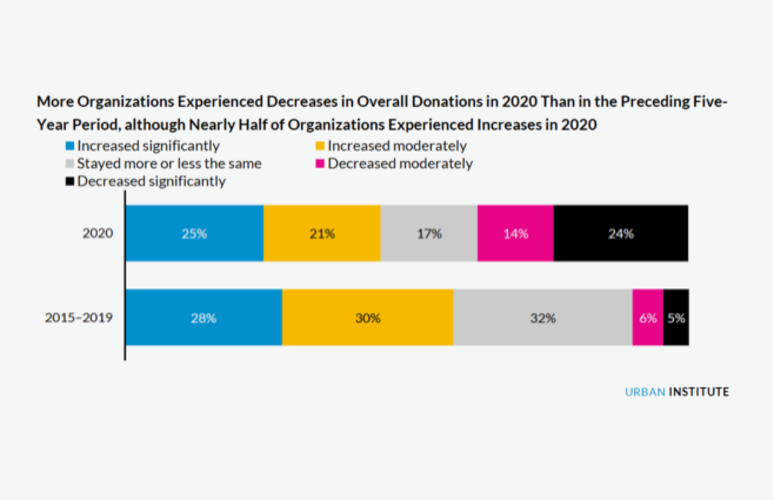Public health, economic, social, and civic disruptions of 2020 showed that positive trends in fundraising are vulnerable to shocks, even when the trend for giving, in general, was moving upward.
Even though 46% of organizations reported increases in donations during 2020, the share of organizations for which donations decreased grew threefold, to 37%, according to data from the Urban Institute and the Center on Charitable Statistics. The report, titled “Nonprofit Trends and Impacts 2021,” was funded by Generosity Commission, a project of the Giving Institute and Giving USA Foundation.
A team of researchers from American University, George Mason University, and the Urban Institute asked nonprofit managers 35 questions covering financial, programs and operations. Surveying went from January through April 2021. Additional data was added via Internal Revenue Service (IRS) Forms 990 and 990 EZ, the 2018 American Community Survey 5-Year Estimates, the Center for Health Statistics Data and the Federal Office of Rural Health Policy Designations.
The events of 2020 dramatically impacted nonprofits of all types and sizes, according to the report’s authors. Some 40% of organizations reported losses in total revenue for 2020, including 54% of arts organizations and 36% of all other responding nonprofits. Organizations that reported losses came in at average of 31% of total revenue and 7% of their paid staff by the end of the year.
Nonprofits reported that roughly 61% of all donations they received in 2019 were less than $250. Organizations with annual budgets less than $500,000 reported that larger shares of their donations were less than $250 (64%) than did organizations with budgets of $500,000 or more (57%). More organizations experienced fluctuations in donations during 2020 than in 2015–2019. Donations of less than $250 stayed the same for 27% of responses during 2020 versus 48% in 2015–2019. Donations of $250 or more stayed the same for 27%in 2020 versus 45% in 2015–2019.
The COVID-19 pandemic damaged services, dropping program service revenue, the data shows. Among organizations that reported receiving fees for service, those fees declined by 30% at the median in 2020.
Other key findings include:
- Donations from individuals are essential. Donations from individuals are essential resources for the nonprofits represented in this study. Roughly three out of four nonprofit managers view individual donations as essential or very important for their work, and small nonprofits, defined as those with expenses under $500,000, depend even more on individual donations.
Organizations with annual budgets less than $500,000 make up more than 60% of the nonprofits represented in this study, and report that roughly 30% of their revenue is from individual donations, compared with 18% for large organizations, defined as those with annual budgets of $500,000 or more.
- Most organizations experienced donation growth from 2015 through 2019, but for many, that trend reversed in 2020. From 2015 through 2019, 58% of organizations experienced growth in donations, 32% experienced stable donations, and 10% experienced decreased donations, according to data in the report.
The events of 2020 disrupted this trend for many nonprofits. More organizations (37% overall) reported decreased donations in 2020 than in the five preceding years, which was true for all categories of nonprofits represented in the study.
- Donation trends from 2015 through 2019 reveal disparities between organizations led by non-Hispanic white people and those led by people of color (POC). A greater share of POC-led organizations experienced declines in donations from 2015 to 2019 and a smaller share experienced increases in donations during that period compared with non-Hispanic-white-led organizations. However, in 2020, organizations led by non-Hispanic white executive directors and executive directors of color experienced similar trends.
To read the full report, go to https://urbn.is/38bd0jE











